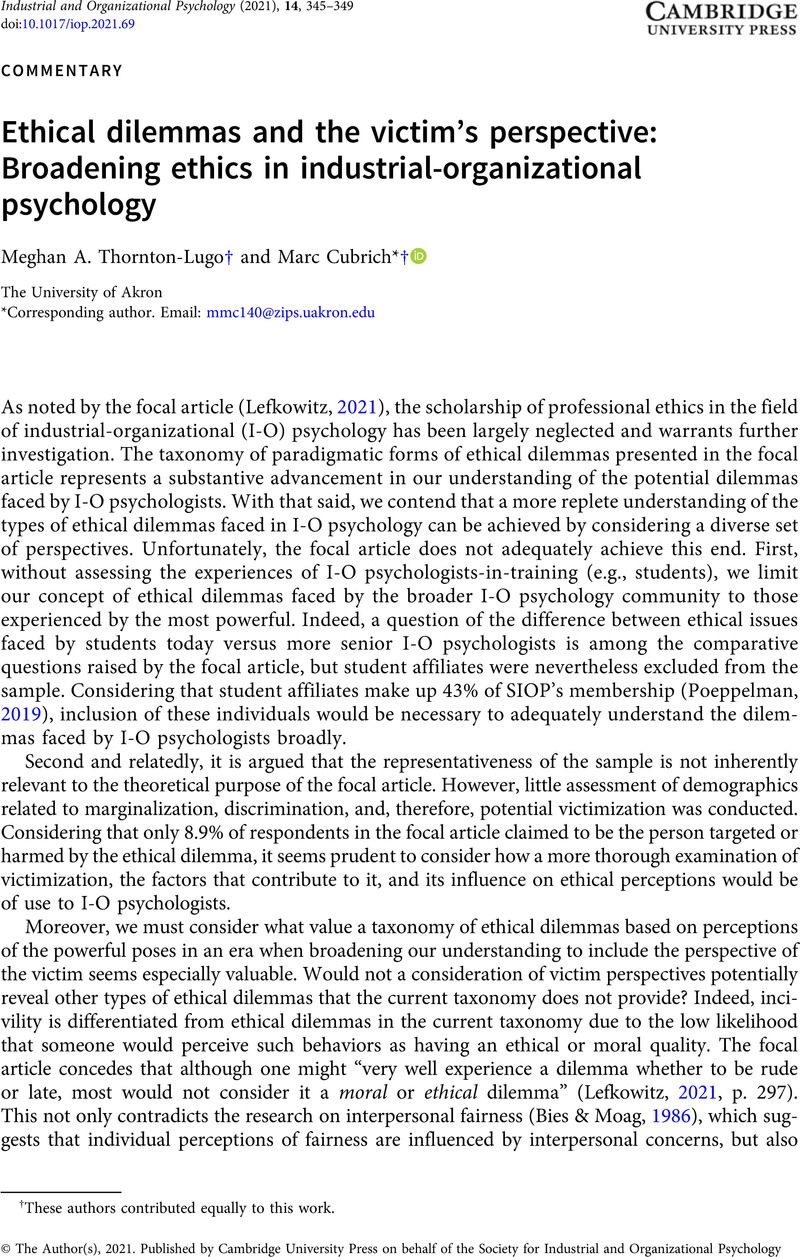No CrossRef data available.
Article contents
Ethical dilemmas and the victim’s perspective: Broadening ethics in industrial-organizational psychology
Published online by Cambridge University Press: 22 September 2021
Abstract
An abstract is not available for this content so a preview has been provided. Please use the Get access link above for information on how to access this content.

- Type
- Commentaries
- Information
- Copyright
- © The Author(s), 2021. Published by Cambridge University Press on behalf of the Society for Industrial and Organizational Psychology
Footnotes
†
These authors contributed equally to this work.
References
Bandura, A. (1991). Social cognitive theory of moral thought and action. In Kurtines, W. M. & Gewirtz, J. L. (Eds.), Handbook of moral development (pp. 45–103). Lawrence Erlbaum Associates.Google Scholar
Bies, R. J., & Moag, J. S. (1986). Interactional justice: Communication criteria of fairness. In Lewicki, R. J., Sheppard, B. H., & Bazerman, M. H. (Eds.), Research on negotiations in organizations (pp. 43–55). JAI Press.Google Scholar
Bowen, F., & Blackmon, K. (2003). Spirals of silence: The dynamic effects of diversity on organizational voice. Journal of Management Studies, 40(6), 1393–1417. https://doi.org/10.1111/1467-6486.00385
CrossRefGoogle Scholar
Chan, M. E., & McAllister, D. J. (2014). Abusive supervision through the lens of employee state paranoia. Academy of Management Review, 39(1), 44–66. https://doi.org/10.5465/amr.2011.0419
CrossRefGoogle Scholar
Cortina, L. M. (2008). Unseen injustice: Incivility as modern discrimination in organizations. Academy of Management Review, 33(1), 55–75. https://doi.org/10.5465/amr.2008.27745097
CrossRefGoogle Scholar
Cortina, L. M. (2017). From victim precipitation to perpetrator predation: Toward a new paradigm for understanding workplace aggression. In Bowling, N. & Hershcovis, M. S. (Eds.), Research and theory on workplace aggression (pp. 121–135). Cambridge University Press.CrossRefGoogle Scholar
Cortina, L. M., & Magley, V. J. (2003). Raising voice, risking retaliation: Events following interpersonal mistreatment in the workplace. Journal of Occupational Health Psychology, 8(4), 247–265. https://doi.org/10.1037/1076-8998.8.4.247
CrossRefGoogle ScholarPubMed
Cortina, L. M., Rabelo, V. C., & Holland, K. J. (2018). Beyond blaming the victim: Toward a more progressive understanding of workplace mistreatment. Industrial and Organizational Psychology: Perspectives on Science and Practice, 11(1), 81–100. https://doi.org/10.1017/iop.2017.54
CrossRefGoogle Scholar
De Judicibus, M., & McCabe, M. P. (2001). Blaming the target of sexual harassment: Impact of gender role, sexist attitudes, and work role. Sex Roles, 44(7–8), 401–417. https://doi.org/10.1023/A:1011926027920
CrossRefGoogle Scholar
Furnham, A. (2003). Belief in a just world: Research progress over the past decade. Personality and Individual Differences, 34(5), 795–817. https://doi.org/10.1016/S0191-8869(02)00072-7
CrossRefGoogle Scholar
Haslam, N. (2006). Dehumanization: An integrative review. Personality and Social Psychology Review, 10(3), 252–264. https://doi.org/10.1207/s15327957pspr1003_4
CrossRefGoogle Scholar
Haslam, N., & Loughnan, S. (2014). Dehumanization and infrahumanization. Annual Review of Psychology, 65, 399–423. https://doi.org/10.1146/annurev-psych-010213-115045
CrossRefGoogle ScholarPubMed
Henle, C. A., & Gross, M. A. (2014). What have I done to deserve this? Effects of employee personality and emotion on abusive supervision. Journal of Business Ethics, 122(3), 461–474. https://doi.org/10.1007/s10551-013-1771-6
CrossRefGoogle Scholar
Kay, A. C., Jost, J. T., & Young, S. (2005). Victim derogation and victim enhancement as alternate routes to system justification. Psychological Science, 16(3), 240–246. https://doi.org/10.1111/j.0956-7976.2005.00810.x
CrossRefGoogle ScholarPubMed
Lefkowitz, J. (2021). Forms of ethical dilemmas in industrial-organizational psychology. Industrial and Organizational Psychology: Perspectives on Science and Practice, 14(3), 297–319.Google Scholar
Lerner, M. J. (1980). The belief in a just world: A fundamental delusion. Plenum.CrossRefGoogle Scholar
Lerner, M. J., & Miller, D. T. (1978). Just world research and the attribution process: Looking back and ahead. Psychological Bulletin, 85(5), 1030–1051. https://doi.org/10.1037/0033-2909.85.5.1030
CrossRefGoogle Scholar
Meares, M. M., Oetzel, J. G., Torres, A., Derkacs, D., & Ginossar, T. (2004). Employee mistreatment and muted voices in the culturally diverse workplace. Journal of Applied Communication Research, 32(1), 4–27. https://doi.org/10.1080/0090988042000178121
CrossRefGoogle Scholar
Milam, A. C., Spitzmueller, C., & Penney, L. M. (2009). Investigating individual differences among targets of workplace incivility. Journal of Occupational Health Psychology, 14(1), 58–69. https://doi.org/10.1037/a0012683
CrossRefGoogle ScholarPubMed
Poeppelman, T. (2019, July 2). SIOP membership committee: An inside look. https://www.siop.org/Career-Center/Calls-and-Announcements/ArtMID/19859/ArticleID/3023/SIOP-Membership-Committee-An-Inside-Look.Google Scholar
Samnani, A. K. (2013). “Is this bullying?” Understanding target and witness reactions. Journal of Managerial Psychology, 28(3), 290–305. https://doi.org/10.1108/02683941311321196
CrossRefGoogle Scholar
Samnani, A. K., & Singh, P. (2016). Workplace bullying: Considering the interaction between individual and work environment. Journal of Business Ethics, 139(3), 537–549. https://doi.org/10.1007/s10551-015-2653-x
CrossRefGoogle Scholar
Scott, K. L., Restubog, S. L. D., & Zagenczyk, T. J. (2013). A social exchange-based model of the antecedents of workplace exclusion. Journal of Applied Psychology, 98(1), 37–48. https://doi.org/10.1037/a0030135
CrossRefGoogle ScholarPubMed
Skarlicki, D. P., & Turner, R. A. (2014). Unfairness begets unfairness: Victim derogation bias in employee ratings. Organizational Behavior and Human Decision Processes, 124(1), 34–46. https://doi.org/10.1016/j.obhdp.2013.11.004
CrossRefGoogle Scholar
Väyrynen, T., & Laari-Salmela, S. (2018). Men, mammals, or machines? Dehumanization embedded in organizational practices. Journal of Business Ethics, 147(1), 95–113. https://doi.org/10.1007/s10551-015-2947-z
CrossRefGoogle Scholar
Wu, L., Wei, L., & Hui, C. (2011). Dispositional antecedents and consequences of workplace ostracism: An empirical examination. Frontiers of Business Research in China, 5(1), 23–44. https://doi.org/10.1007/s11782-011-0119-2
CrossRefGoogle Scholar




